Smart Building Market Size
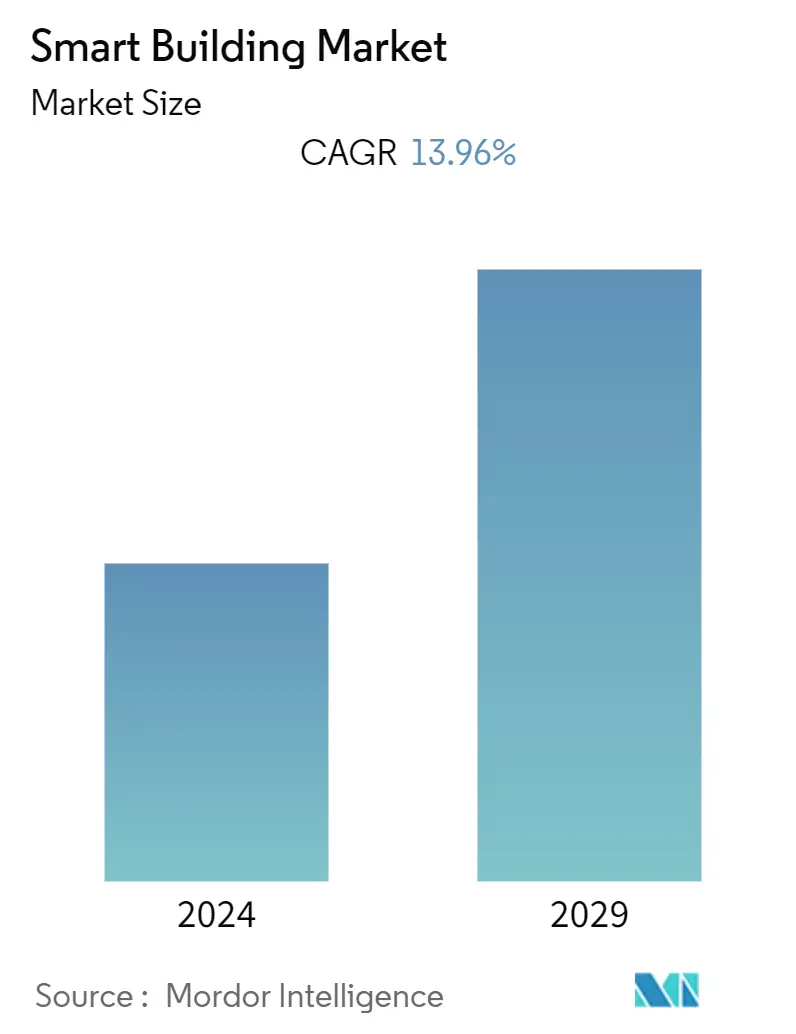
| Study Period | 2019 - 2029 |
| Base Year For Estimation | 2023 |
| CAGR (2024 - 2029) | 13.96 % |
| Fastest Growing Market | Asia Pacific |
| Largest Market | North America |
| Market Concentration | Low |
Major Players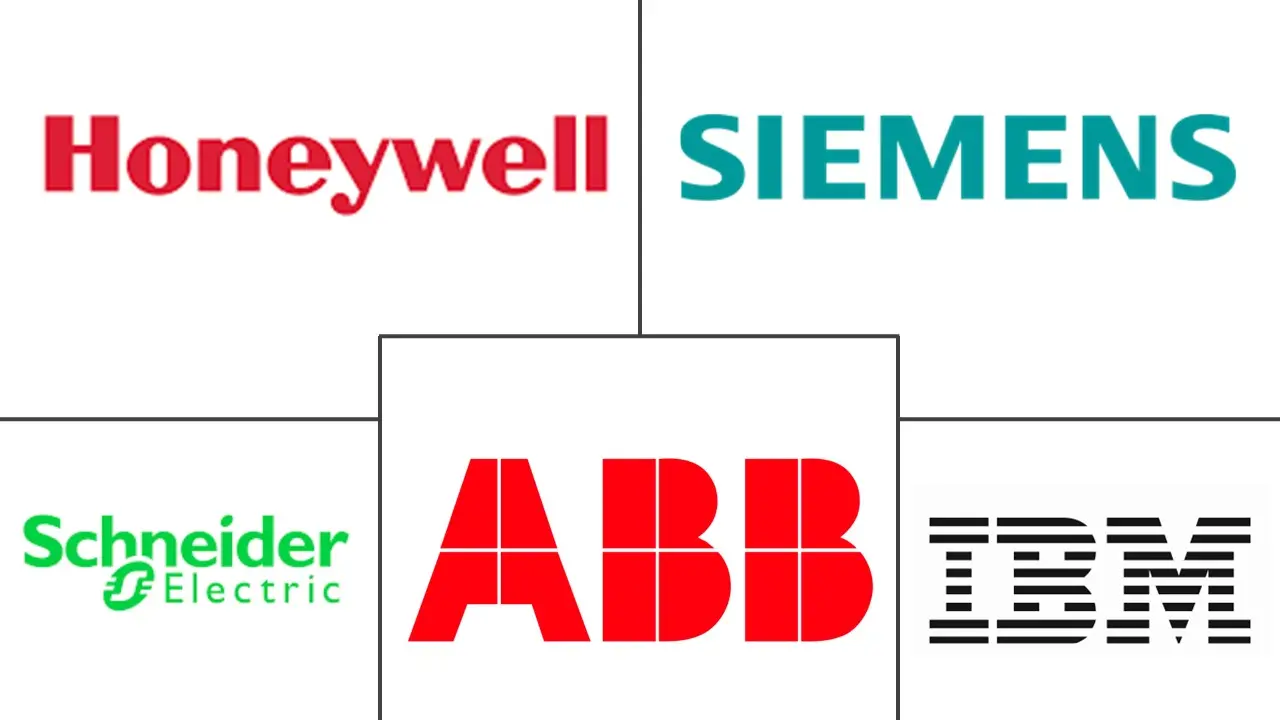
*Disclaimer: Major Players sorted in no particular order |
Smart Building Market Analysis
The Smart Building Market is expected to register a CAGR of 13.96% during the forecast period.
The growing smart cities sector, rising demand for energy-efficient buildings, and developments by market players are expected to drive the demand for smart buildings.
- The concept of smart cities created considerable opportunities in the energy, waste, and infrastructure sectors with the Internet of Things. Smart homes, a significant trend in smart city concepts, have several advantages. Several smart city projects and initiatives are currently underway. Many smart city projects and initiatives are being implemented worldwide, driving global investment through urbanization. The OECD estimates that global investment in smart city initiatives may reach approximately USD 1.8 trillion between 2010 and 2030 across all metropolitan infrastructure projects.
- Rising concerns about the surge in energy consumption globally are anticipated to fuel more advanced and energy-efficient technologies. However, stringent governance on energy consumption and green building initiatives also augment the demand for energy-efficient technology across buildings. This factor is expected to propel the implementation of smart building solutions globally.
- Therefore, businesses in any industry can adopt IoT devices, comprising smart thermostats and lighting systems, to minimize their electrical consumption and make buildings more sustainable. Since the adoption of IoT-enabled building management systems is increasing rapidly, it is creating awareness about space utilization industry standards and efficient energy usage.
- In addition to this, the demand is pushing energy services and technology companies to integrate their solutions and develop advanced mechanisms that can help consumers address challenges such as high energy bills and the removal of manual processes in doing so. The rapid pace of technological innovation presents exciting opportunities to enhance people's lives and promote sustainability. This furthermore provides lucrative opportunities for players to expand their position in the market with strategic developments.
- However, the market's growth is expected to be hampered by a shortage of competent professionals skilled in evaluating smart solution systems. Professionals in this field must be aware of design modifications and installations for future needs.
- The office reopening post-COVID-19 was projected to increase the smart technology demand for safe surroundings. Facility managers and tenant companies of commercial buildings needed to provide a secure office environment post-lockdown. Therefore, smart technology could manage regular cleaning and disinfection, proper ventilation of offices, smart access controls, temperature measurement devices, and optimization of spaces to maintain physical distancing. These factors are anticipated to increase the demand for smart building solutions.
Smart Building Market Trends
Intelligent Security Systems to be the Fastest Growing Solution Segment
- Intelligent security systems in the market refer to technologies and solutions that use automation, sensors, and data analytics to enhance the safety and security of occupants and assets within a building.
- With the steady growth of smart cities and intelligent buildings, there comes an inherent need for greater security for property and individuals. As facilities become more connected, security breaches and invasions are also predicted. Some intelligent security system solutions used in smart buildings are fire safety, video surveillance, access controls, theft detection, intrusion detection, network systems, etc.
- According to the IMD Smart City Index 2023, Zurich is an advanced smart city with the highest Human Development Index score, making it one of the most livable cities in the world. Notable exceptions to the HDI to IMD index were Dubai, Beijing, and Abu Dhabi. Beijing is a notable outlier, ranking 12th in the Digital Smart City rankings, but is almost 90 points behind Zurich in the HDI score. On the other hand, Munich is the 20th digital city with an HDI value of 950.
- IoT-enabled emergency lighting solutions are designed to provide a wide range of solutions for safe evacuation in some emergency or fire for all buildings, from hotels to offices, schools, hospitals, stadiums, and train stations. These solutions drive more excellent security solutions for intelligent buildings and give a more holistic approach while reducing the total cost of ownership throughout the building life cycle.
- The leverage of IoT-enabled tools, such as motion detection, presence simulation, and remote video access, will put greater control back in the hands of the customer. Solutions like door entry systems now provide commissioning and good usage for enhanced security and communication by offering interaction between door entry, access control, and video surveillance so that distance in buildings is now only a matter of IP connectivity. Intelligent security technology solutions can further assist in monitoring a building and warn about unauthorized entry. These systems can also supervise safe building evacuation, emergency call stations, and detection alarms for water, smoke, and gas leaks.
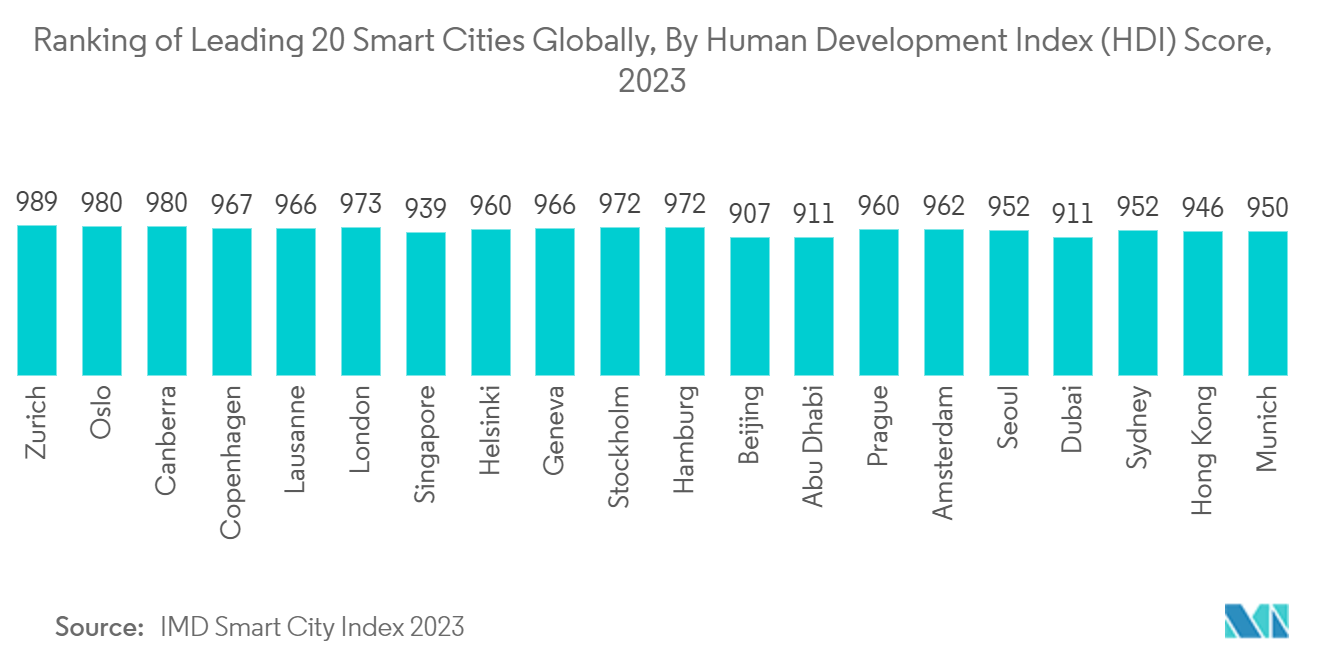
North America is Expected to Hold Significant Market Share
- North America is one of the significant markets for smart buildings and IoT-enabled smart devices, and the region witnesses an increased application and acceptance of smart building solutions.
- By solution, intelligent security system is expected to grow exponentially in North America. With increasing environmental awareness, more Americans are looking for connected, smart, and automated building solutions with add-in capabilities, like fire safety, safety and alarm systems, surveillance, and security. Hence, IoT-enabled smart building solutions are widely accepted in the United States.
- In the North American region, the United States is one of the largest IoT-enabled markets as it is the largest consumer of IoT-compatible devices. Moreover, it has the highest number of ongoing IoT projects related to smart and connected buildings, smart energy, and smart cities, which is expected to create ample growth opportunities for the market.
- High Internet Speed and greater internet penetration make the North American countries an ideal hotspot for IoT, AI, and Smart Buildings projects. Consumer spending capabilities for newer technology are also augmenting the adoption and driving vendors to introduce new solutions targeting different needs. With minimized semiconductor and sensor costs, more companies and start-ups are thus working together to produce better Smart Building Technology. The United States, especially being a hub for start-ups and its robust economic and financial presence, has become a significant spot for new technology markets, including Smart Building Solutions.
- In November 2022, View Inc., a provider of smart building technologies, introduced the View Partner Marketplace, an app store available to the customers of the company's recently launched Smart Building Cloud, the industry's first complete cloud-native platform for smart buildings. The View Partner Marketplace allows customers to deploy popular real estate applications, software platforms, and sensors with a single click, making it much easier for owners and operators to digitize their portfolios quickly and securely.
- Overall, with the rise in developments related to smart buildings, including partnerships, product launches, and investments, the market is expected to expand comprehensively.
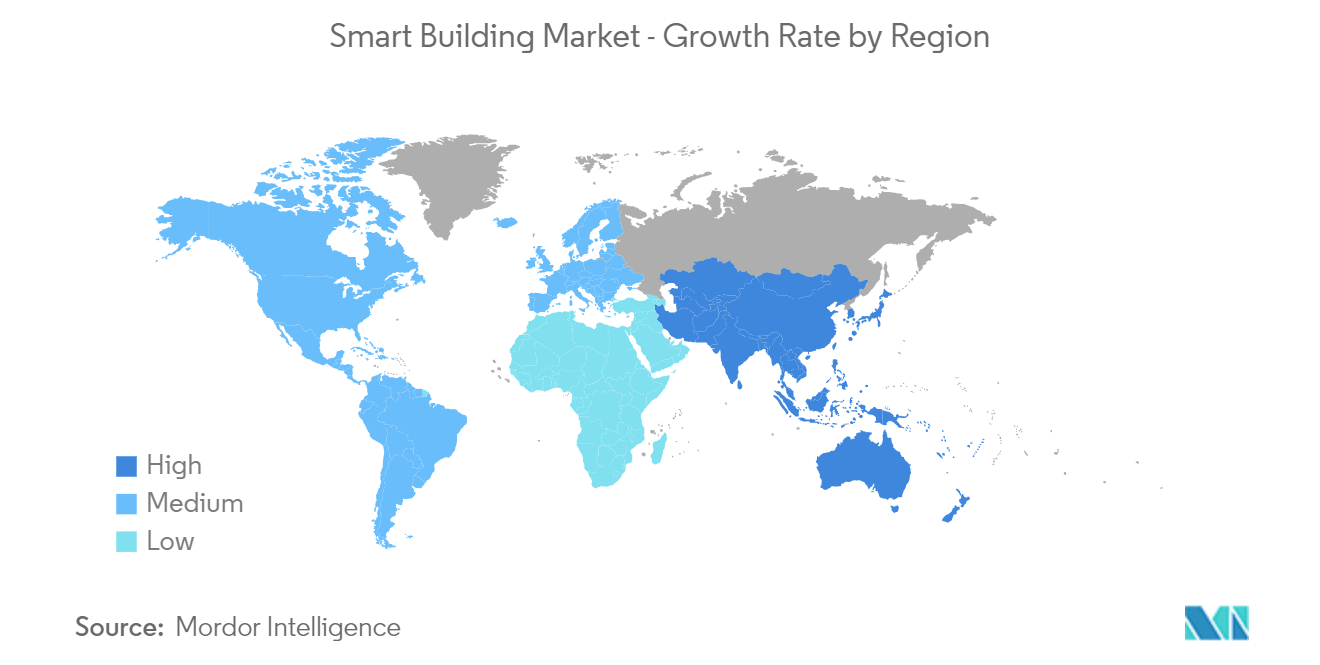
Smart Building Industry Overview
The smart buildings market is fragmented, with a presence of reputable global and national companies worldwide. The market is expected to be driven by customizations and modern technologies to attract end users. Suppliers are mainly focused on providing innovative solutions and products that can optimize energy consumption and meet high levels of building automation. Furthermore, companies are involved in various strategies to gain a competitive edge. Some of the major players in the market are Honeywell International Inc., Siemens AG, ABB Ltd, Schneider Electric SE, and IBM Corporation.
- In July 2023, Siemens partnered with PRODEA Investments, one of the real estate investment companies in Greece, to implement Building X. Building X is a Siemens digital building platform.
- In April 2023, Obayashi Corporation and Hitachi Solutions Ltd incorporated Oprizon Ltd, a joint venture for providing smart building-related services, based on the Joint Venture Agreement executed in January 2023, to become the leading smart building service provider and started operation in April 2023.
Smart Building Market Leaders
-
Honeywell International Inc.
-
Siemens AG
-
Schneider Electric SE
-
IBM Corporation
-
ABB Ltd
*Disclaimer: Major Players sorted in no particular order
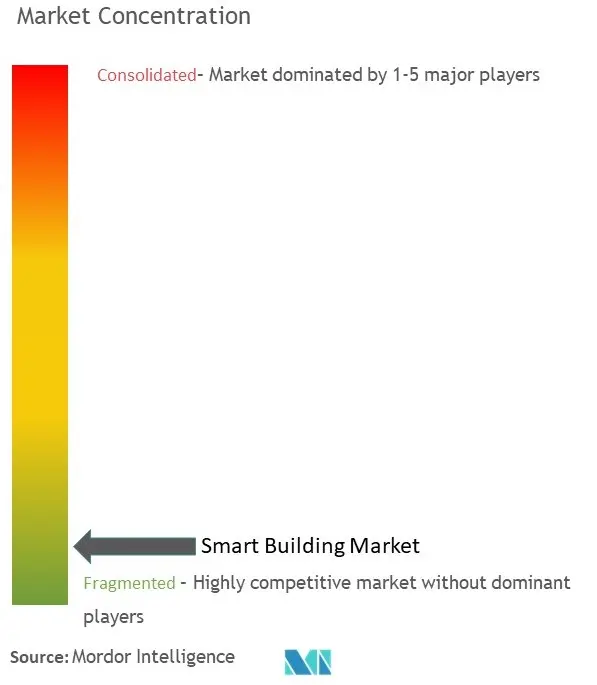
Smart Building Market News
- In March 2023, Siemens Smart Infrastructure introduced Connect Box, an open and easy-to-use IoT solution for small- to medium-sized buildings. The addition to the Siemens Xcelerator portfolio, Connect Box, is mainly a user-friendly approach for monitoring building performance, with the potential to optimize energy efficiency by up to around 30% and to substantially improve the overall indoor air quality in small to medium-sized buildings such as schools, retail shops, apartments, or small offices.
- In May 2023, Delta, a global provider of power and thermal management solutions, announced a smart community hub enabled by its broader portfolio of IoT-based Smart Green Solutions. The "Intelligent Sustainable Connecting Hub" features an intelligent Operation Center with a multi-functional management platform for companies to manage critical operations, including carbon emissions inventory and renewable power matching. Moreover, the new VORTEX, cloud-based video surveillance as a service (VSaaS), the smart microgrid-supported EV charging infrastructure, and the energy-efficient data center solution demonstrate how Delta's solutions integrate seamlessly to ensure the sustainable development of many sectors.
Smart Building Market Report - Table of Contents
1. INTRODUCTION
- 1.1 Study Assumptions and Market Definition
- 1.2 Scope of the Study
2. RESEARCH METHODOLOGY
3. EXECUTIVE SUMMARY
4. MARKET INSIGHTS
- 4.1 Market Overview
- 4.2 Industry Value Chain Analysis
-
4.3 Industry Attractiveness - Porter's Five Forces Analysis
- 4.3.1 Threat of New Entrants
- 4.3.2 Bargaining Power of Buyers
- 4.3.3 Bargaining Power of Suppliers
- 4.3.4 Threat of Substitute Products
- 4.3.5 Intensity of Competitive Rivalry
- 4.4 Assessment of COVID-19's Impact on the Market
5. MARKET INSIGHTS
-
5.1 Market Drivers
- 5.1.1 Growing Concerns about the Energy Consumption Leading to Adopt Smart Solutions
- 5.1.2 Government Initiatives on Smart Infrastructure Projects
-
5.2 Market Challenges
- 5.2.1 Lack of Technology Alignment and Skilled Professionals
6. MARKET SEGMENTATION
-
6.1 By Component
- 6.1.1 Solutions
- 6.1.1.1 Building Energy Management Systems
- 6.1.1.2 Infrastructure Management Systems
- 6.1.1.3 Intelligent Security Systems
- 6.1.1.4 Other Solutions
- 6.1.2 Services
-
6.2 By Application
- 6.2.1 Residential
- 6.2.2 Commercial
-
6.3 By Geography
- 6.3.1 North America
- 6.3.2 Europe
- 6.3.3 Asia-Pacific
- 6.3.4 Latin America
- 6.3.5 Middle East and Africa
7. COMPETITIVE LANDSCAPE
-
7.1 Company Profiles
- 7.1.1 Honeywell International Inc.
- 7.1.2 Siemens AG
- 7.1.3 ABB Ltd.
- 7.1.4 Schneider Electric SE
- 7.1.5 IBM Corporation
- 7.1.6 Huawei Technologies Co. Ltd
- 7.1.7 Cisco Systems Inc.
- 7.1.8 Johnson Controls International PLC
- 7.1.9 Legrand SA
- 7.1.10 Avnet Inc.
- 7.1.11 Hitachi Ltd
- 7.1.12 Softdel (A UNIDEL Company)
- *List Not Exhaustive
8. INVESTMENT ANALYSIS
9. FUTURE OF THE MARKET
** Subject To AvailablitySmart Building Industry Segmentation
Smart buildings automate processes that control lighting, infrastructure, heating, security systems, ventilation, and air conditioning. Smart buildings integrate technology into basic building infrastructure and other equipment, components, and structures to make buildings safer, more efficient, and sustainable and reduce costs. The smart building solutions investigated are part of the rising IoT and connected sensor ecosystem. Smart buildings use automation to optimize all or some of the processes inside the building: heating and cooling, ventilation, security, lighting, water usage, and more. Some benefits include reduced environmental impact, proactive maintenance of equipment, and reduced energy use and costs.
The Smart Building Market is segmented by Component (Solutions (Building Energy Management Systems, Infrastructure Management Systems, Intelligent Security Systems), Services), by Application (Residential, Commercial), and by Geography (North America, Europe, Asia-Pacific, Latin America, and Middle East & Africa). The market sizes and forecasts are provided in terms of value in USD for all the above segments.
| By Component | Solutions | Building Energy Management Systems |
| Infrastructure Management Systems | ||
| Intelligent Security Systems | ||
| Other Solutions | ||
| By Component | Services | |
| By Application | Residential | |
| Commercial | ||
| By Geography | North America | |
| Europe | ||
| Asia-Pacific | ||
| Latin America | ||
| Middle East and Africa |
Smart Building Market Research FAQs
What is the current Smart Building Market size?
The Smart Building Market is projected to register a CAGR of 13.96% during the forecast period (2024-2029)
Who are the key players in Smart Building Market?
Honeywell International Inc., Siemens AG, Schneider Electric SE, IBM Corporation and ABB Ltd are the major companies operating in the Smart Building Market.
Which is the fastest growing region in Smart Building Market?
Asia Pacific is estimated to grow at the highest CAGR over the forecast period (2024-2029).
Which region has the biggest share in Smart Building Market?
In 2024, the North America accounts for the largest market share in Smart Building Market.
What years does this Smart Building Market cover?
The report covers the Smart Building Market historical market size for years: 2019, 2020, 2021, 2022 and 2023. The report also forecasts the Smart Building Market size for years: 2024, 2025, 2026, 2027, 2028 and 2029.
What are the key factors driving Smart Building Market?
Key factors driving the smart buildings market are: a) Growing concerns about energy consumption and b) Government initiatives on smart infrastructure projects
Smart Building Industry Report
The global smart buildings market is experiencing significant growth, driven by the increasing demand for energy-efficient systems and advancements in IoT and PoE solutions. These smart building solutions provide valuable insights into energy consumption across building infrastructures, enabling efficient monitoring and control. Despite the high cost of implementation and a lack of awareness about long-term cost savings posing challenges, the market continues to expand. The emergence of 5G technology is expected to further enhance the capabilities of intelligent buildings, expanding the use of IoT-enabled devices and providing efficient real-time operational and analytics capabilities. However, privacy and security concerns due to these IoT-enabled devices remain a challenge.
The market is segmented by components, including solutions such as building energy management systems, infrastructure management systems, and intelligent security systems, as well as services. The service segment is anticipated to see a higher growth rate due to the growing demand for smart building solutions aimed at improving facility performance and management. North America is estimated to hold the highest market share, driven by rapid digitalization, increasing adoption of smart connected devices, and rising technological advancements.
Mordor Intelligence™ Industry Reports provide comprehensive industry analysis, including industry trends, industry outlook, and industry statistics. These reports offer detailed market data, market forecast, market overview, and market segmentation, helping stakeholders understand market growth and market value. The reports also include industry research, industry information, industry size, and market predictions, offering valuable insights into market leaders and market review. For those interested in further details, a report example and report pdf can be obtained from Mordor Intelligence™.
The market research indicates that the global market for smart buildings is poised for substantial growth, supported by the increasing implementation of energy-efficient systems and advanced IoT solutions. This growth is further bolstered by industry sales and industry reports, which highlight the market's potential. The market outlook remains positive, with continuous advancements in technology and a growing emphasis on sustainable building practices.



